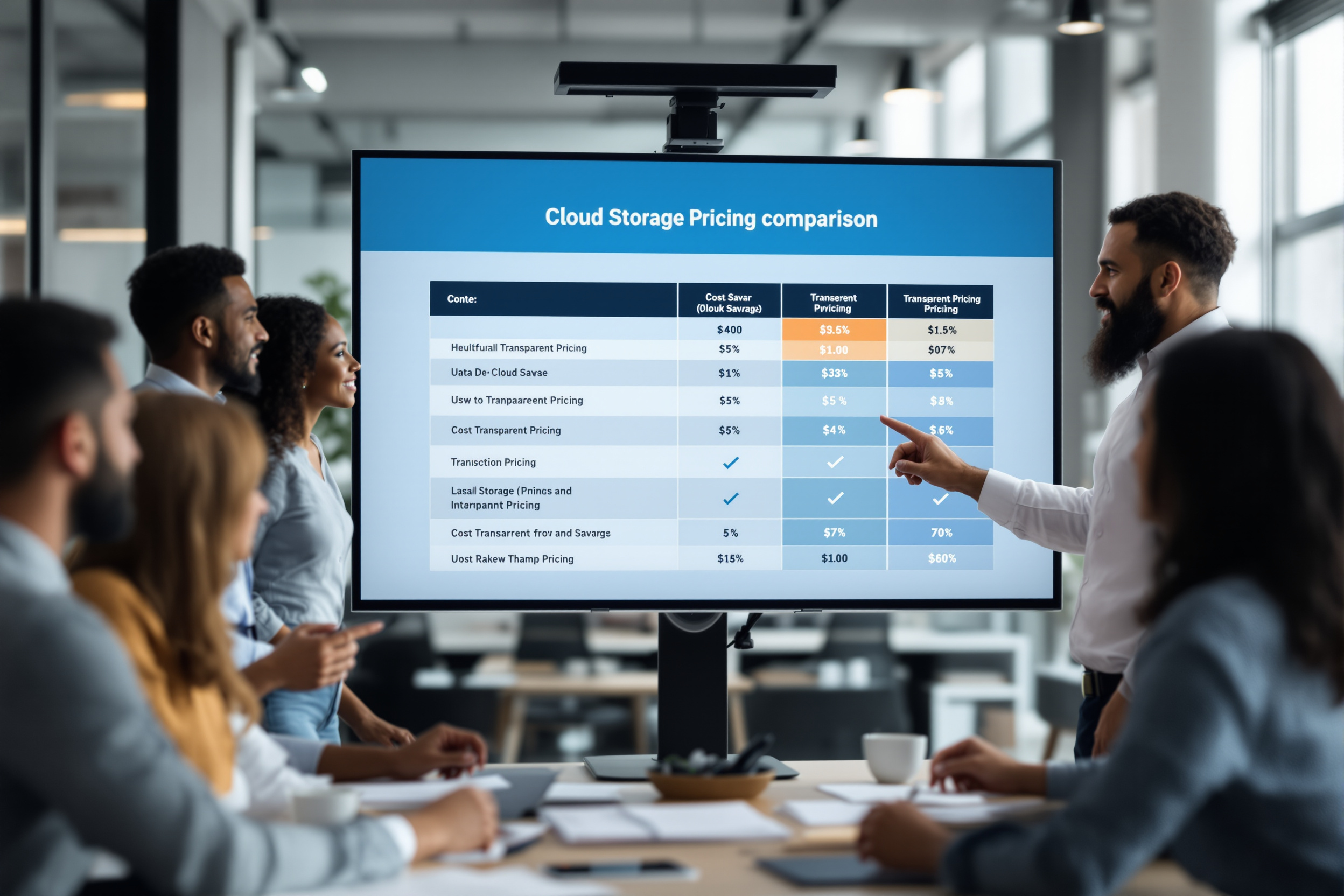Topics on this page
The conversation around cloud storage pricing is changing fundamentally in 2025. For years, IT leaders and MSPs focused on the per-gigabyte price, but this overlooks the hidden charges that cause budget overruns. Egress fees, API call charges, and minimum storage durations can inflate total costs by 60-80%. This article explores a modern, predictable approach to cloud storage economics. We will detail how to achieve significant cost savings, enhance ransomware protection, and break free from vendor lock-in with a transparent, S3-compatible alternative designed for enterprise workloads.
Key Takeaways
- Eliminate surprise costs by choosing a cloud storage provider with a transparent pricing model that has zero egress fees, no API call charges, and no minimum storage durations, saving up to 80% on total costs.
- Prioritize an "Always-Hot" storage architecture to ensure all data is instantly accessible, which improves backup and restore performance by up to 20% and eliminates retrieval delays common with tiered storage.
- Demand more than just S3 API compatibility; ensure your provider offers enterprise-grade features like immutable Object Lock for ransomware protection and compliance certifications like SOC 2 and ISO 27001.
The Hidden Costs Eroding Cloud Budgets
Cost unpredictability is the number one pain point for 95% of enterprises using cloud storage. Many organizations are blindsided by charges for data egress, API requests, and retrieval, which are often buried in complex pricing models. These extra fees can cause total expenses to swell by 3-5x the initial storage cost for data-intensive workloads. A recent study revealed that 55% of IT leaders see egress costs as the biggest barrier to switching providers, creating significant vendor lock-in.
This financial uncertainty forces businesses into difficult trade-offs. To avoid surprise bills, 56% of companies reduce the size of datasets stored in the cloud, while 45% shorten their storage duration policies. Such compromises limit the data available for analytics and AI, directly hindering innovation. A predictable pricing model-one with no egress fees or API charges-is the only way to make cloud costs predictable and unlock the full value of your data.
Why S3 Compatibility Alone Is No Longer a Differentiator
The S3 API has become the industry standard, ensuring tools and applications work seamlessly across different storage platforms. This interoperability is crucial, as it allows businesses to migrate data without rewriting code, saving thousands of hours in development time. However, simply being S3-compatible is now table stakes; true value lies in the architecture and economic model built around it. Many providers offer S3 compatibility but still impose the same punitive fees and complex tiering that create lock-in.
An enterprise-ready S3 alternative must deliver more than just API parity. It requires a commitment to open standards and data portability. The goal is a true drop-in replacement where you only change the endpoint, not your entire workflow or budget strategy. This approach protects past investments and provides a built-in exit strategy, ensuring you retain negotiating power and long-term freedom. True S3-compatible storage offers both technical and financial independence.
Achieving Superior Performance with an 'Always-Hot' Architecture
Many cloud storage platforms use complex tiering systems, moving data between hot, cool, and archive layers to manage costs. While this seems efficient, it often creates operational fragility. Retrieving data from cooler tiers can introduce restore delays of minutes or even hours, causing API timeouts and disrupting critical backup and recovery operations. These delays are unacceptable for businesses that require immediate data access for ransomware recovery or analytics.
An "Always-Hot" storage model solves this by keeping 100% of data immediately accessible. This approach offers several key advantages:
- No Restore Delays: All data is available instantly, eliminating retrieval fees and wait times.
- Predictable Performance: It delivers strong read/write consistency and low latency, improving backup performance by up to 20%.
- Simplified Operations: It removes the need for complex lifecycle policies, which are prone to misconfiguration.
- Application Stability: Third-party tools that expect immediate data access remain stable and performant.
This architecture provides the reliability needed for demanding enterprise workloads, from disaster recovery to real-time data analysis. Choosing an always-hot storage model ensures your data is ready when you need it.
Enterprise-Grade Security and Compliance Without the High Price
Ransomware protection is a mission-critical requirement for modern businesses. With backup infrastructure being a primary target for cyberattacks, immutable storage has become non-negotiable. S3 Object Lock provides a write-once-read-many (WORM) model, making data unchangeable and undeletable for a set period. This capability ensures that even if an attacker gains access, they cannot encrypt or destroy your backups, guaranteeing a clean recovery path.
Beyond security, enterprises in regulated industries need verifiable compliance. Leading S3-compatible alternatives offer certifications like SOC 2 and ISO 27001, which validate their commitment to protecting customer data against unauthorized access. These standards are essential for financial services, healthcare, and other sectors handling sensitive information. By combining robust security features with enterprise-grade compliance, businesses can achieve data control and independence without the enterprise pricing of hyperscalers.
A Predictable Model Designed for MSPs and Channel Partners
For Managed Service Providers (MSPs), resellers, and system integrators, profitability hinges on predictable margins. Traditional cloud storage models with fluctuating egress and API fees erode those margins, making it difficult to quote BaaS and DRaaS offerings confidently. A pricing model with zero egress fees, no API charges, and no minimum storage duration is designed for the channel. It ensures the price you quote is the price you pay, leading to stable, defensible margins.
A partner-ready platform should also provide the tools needed for efficient management and growth. Key features include:
- Multi-Tenant Management: A centralized console with role-based access control (RBAC) and multi-factor authentication (MFA) to securely manage multiple clients.
- Automation via API/CLI: Full support for scripting and automation to streamline onboarding and daily operations.
- Simplified Compliance: Easy-to-manage features like Immutable Storage to help clients meet regulatory requirements.
- Transparent Reporting: Clear dashboards to monitor usage and costs without any hidden variables.
This partner-centric approach transforms cost efficiency into a competitive advantage, enabling partners to grow their business profitably.
How to Build an Exit Strategy and Avoid Vendor Lock-In
Vendor lock-in is a strategic risk that limits flexibility and drives up long-term costs. Many organizations feel trapped by proprietary APIs and punitive egress fees that make switching providers prohibitively expensive. An effective cloud strategy requires planning your exit from day one. The key is to choose a platform built on open standards and transparent economics. S3 compatibility is the first step, as it ensures your applications remain portable.
The second, more critical step is selecting a provider with a cost structure that doesn't penalize you for accessing your own data. With no egress fees, you can move data freely between clouds or back on-premises at any time without financial penalty. This preserves your negotiating power and ensures you can always adapt your infrastructure to meet changing business needs. A built-in exit strategy is the ultimate form of data control and independence.
More Links
Statistisches Bundesamt provides statistical data on the use of cloud computing by enterprises in Germany, focusing on the ICT sector.
Bitkom presents a cloud report for 2025, likely covering trends, adoption rates, and market analysis of cloud computing in Germany.
PwC discusses cloud cost optimization and FinOps, focusing on strategies and practices to manage and reduce cloud spending.
Deloitte focuses on establishing a cloud strategy, likely covering aspects such as cloud adoption, migration, and governance.
KPMG provides an overview of cloud computing, potentially covering various aspects such as cloud strategy, implementation, and security.
Eurostat presents news and statistics related to cloud computing, potentially covering adoption and usage across European countries.
FAQ
What should I look for in cloud storage pricing in 2025?
In 2025, look for a transparent, predictable pricing model. Prioritize providers that offer zero egress fees, no charges for API calls, and no minimum storage durations. This approach can reduce your total cost of ownership by 60-80% compared to traditional models.
Is S3 compatibility enough for an enterprise solution?
While S3 compatibility is essential for tool and application interoperability, it is not enough on its own. An enterprise-ready solution must also provide a high-performance architecture, robust security features like immutable Object Lock, enterprise compliance (SOC 2, ISO 27001), and a pricing model that prevents vendor lock-in.
What is an 'Always-Hot' storage architecture?
An 'Always-Hot' storage architecture ensures all data is stored in a single, high-performance tier and is always immediately accessible. This eliminates the complexity, retrieval delays, and hidden fees associated with tiered storage models (hot, cool, archive), making it ideal for backup, disaster recovery, and analytics.
How does immutable storage protect against ransomware?
Immutable storage, enabled by features like S3 Object Lock, protects against ransomware by making your data unchangeable and undeletable for a specified retention period. Even if attackers gain access to your systems, they cannot encrypt or modify your immutable backups, guaranteeing you can restore clean data.
What is vendor lock-in and how can I avoid it?
Vendor lock-in occurs when you become dependent on a single cloud provider due to proprietary technology or prohibitive switching costs, like high egress fees. You can avoid it by choosing providers that use open standards like the S3 API and have a transparent pricing model with no egress fees, ensuring you can move your data freely.
What compliance certifications are important for cloud storage?
For enterprises in regulated industries, key certifications include SOC 2, which audits controls related to security and availability, and ISO 27001, an international standard for information security management. These certifications demonstrate a provider's commitment to protecting sensitive data.



.png)
.png)
.png)
.png)



.png)




%201.png)